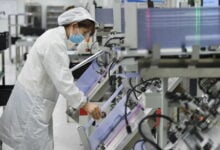Auto boom: Thailand revving up as global car parts powerhouse

Thailand is racing ahead in the fast lane of auto parts manufacturing in the Asia-Pacific region, speeding towards becoming a crucial export hub for Germany’s esteemed Schaeffler Group. Spotlighting both traditional internal combustion engines (ICE) and the rapidly accelerating electric vehicle (EV) industry, Schaeffler is gearing up for an automotive revolution.
Micah Shepard, Schaeffler’s head honcho for vehicle lifetime solutions in the Asia-Pacific, has exciting news: this year, the market value for auto parts for both ICEs and EVs is set to rev up by a healthy 3-4%. And guess what? This growth spurt isn’t hitting the brakes any time soon, as predictions show it could zoom on through until 2025, fuelled by robust regional economic expansion.
Schaeffler, the brain behind friction-busting rolling element bearings, has made a savvy move in Thailand with a brand-new, sprawling warehouse in the Si Racha district of Chon Buri. Stretching over an impressive 3,000 to 6,000 square metres, this state-of-the-art facility is geared up to push out vital vehicle components to both homegrown and global markets.
Thailand’s government is putting the pedal to the metal by pushing the EV industry while still giving a high-five to tried-and-true ICE vehicle makers. Thailand once proudly wore the crown as “the Detroit of Asia,” thanks to its roaring car manufacturing sector.
Right now, old-school oil-guzzling cars and pickups are still the big cheeses, dominating over 85% of production. Meanwhile, electric dreams are still flickering with battery EVs just crossing the starting line at a meagre 1.2% of production as of September 2024, as per the Federation of Thai Industries (FTI).
But fear not eco-warriors, Thailand’s got big plans under its snazzy 30@30 policy. They’re setting their sights on having EVs make up at least 30% of all auto production by 2030.

The motoring milestones to hit include 725,000 zero-emission cars, 675,000 electric motorcycles, and 34,000 electric buses and trucks. The FTI is confident that a fresh wave of automotive investment from both Thai and international players will turbocharge the economy and breathe new life into domestic vehicle sales, Bangkok Post reported.
Schaeffler’s splashy Chon Buri investment is on point with its master plan to create a logistics hub that backs global supply chains for both ICE and EV markets, said Jens Schuler, the big chief for vehicle lifetime solutions at Schaeffler.
“This centre has the potential to support global supply chains for ICEs and EVs.”
In a bold leap towards the future, Schaeffler has its sights set on planting a research and development centre right in the heart of Thailand, with investments greenlit for the first quarter of 2025. The company’s not holding back, usually throwing around 400 million euros (a staggering 14.7 billion baht) each year to bolster its global investment dreams, added Shepard.
“Thailand is a prime location for investment to serve demand from new industries.”
With the wheels in motion, Thailand’s auto industry is gearing up for a thrilling ride into the future.
What Other Media Are Saying
- Schaeffler expands its manufacturing footprint in Asia Pacific with a new facility in Thailand, enhancing customer proximity and competitiveness, particularly in the ASEAN Economic Community. (read more)
- Autoguide India reports Schaeffler inaugurating a new Central Logistics Center in Thailand, enhancing service quality and operational efficiency with improved infrastructure and capabilities. (read more)
Frequently Asked Questions
Here are some common questions asked about this news.
Why is Thailand becoming a pivotal hub for auto parts export?
Thailand’s strategic location, supportive policies, and growing EV industry position it as an ideal export hub for global auto parts.
How might Thailand’s 30@30 policy reshape its automotive industry?
The policy aims to significantly increase EV production, potentially transforming Thailand into a leading EV manufacturer by 2030.
What if Thailand surpasses its EV production targets by 2030?
Exceeding targets could establish Thailand as a global EV leader, attracting more international investments and boosting its economy.
How does the new Schaeffler warehouse impact global supply chains?
The warehouse enhances supply chain efficiency, supporting both domestic and international markets for ICE and EV components.
What role does Schaeffler’s R&D centre play in Thailand’s automotive future?
The R&D centre will foster innovation, supporting Thailand’s shift towards advanced automotive technologies and sustainable transport solutions.
Latest Thailand News
Follow The Thaiger on Google News:


























